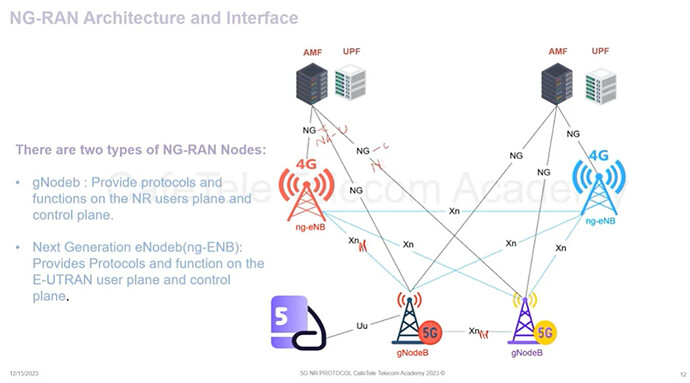5G NR Protocols Latest
In a 5G network, several key protocols play crucial roles in ensuring efficient, reliable, and secure communication. Among these are the SDAP (Service Data Adaptation Protocol), PDCP (Packet Data Convergence Protocol), RLC (Radio Link Control), MAC (Medium Access Control), and RRC (Radio Resource Control) protocols. Each of these protocols operates at different layers of the network and serves specific functions.
-
SDAP (Service Data Adaptation Protocol)
- Function: SDAP is a new layer introduced in the 5G network architecture. It primarily deals with QoS (Quality of Service) flow in the 5G network.
- Role: SDAP maps QoS flows to data radio bearers and performs QoS handling at the packet level. This ensures that data packets receive the appropriate QoS treatment (like prioritization) as per the service requirements.
- Position in Network Stack: SDAP sits above the PDCP layer in the 5G protocol stack.
-
PDCP (Packet Data Convergence Protocol)
- Function: PDCP serves two primary purposes: header compression and encryption. It compresses the headers of IP packets to reduce the amount of data sent over the air.
- Encryption and Integrity: PDCP also encrypts data for security and ensures data integrity, offering protection against threats.
- Role in Handovers: It plays a key role during handovers in the 5G network, particularly in maintaining data continuity.
- Position in Network Stack: It is positioned between the SDAP and RLC layers.
-
RLC (Radio Link Control)
- Function: The RLC layer is responsible for the transfer of upper-layer PDUs (Protocol Data Units).
- Modes of Operation: It operates in three modes: Transparent Mode ™, Unacknowledged Mode (UM), and Acknowledged Mode (AM), each offering different levels of error correction and delivery assurance.
- Segmentation and Reassembly: RLC handles the segmentation and reassembly of PDCP PDUs, ensuring they fit into the lower layer’s transport blocks.
- Position in Network Stack: RLC is located between the PDCP and MAC layers.
-
MAC (Medium Access Control)
- Function: The MAC layer is crucial for channel access and multiplexing of the transport channels onto the physical channels.
- Scheduling and Allocation: It is responsible for scheduling and allocating resources to the UEs (User Equipment) in both uplink and downlink directions.
- HARQ Management: MAC also handles HARQ (Hybrid Automatic Repeat Request) processes for error correction.
- Position in Network Stack: The MAC layer interfaces directly with the physical layer and is positioned just above it.
-
RRC (Radio Resource Control)
- Function: RRC is responsible for the overall control of the radio resources.
- Key Responsibilities: These include broadcasting system information, paging, establishing and releasing RRC connections, and managing mobility when the device is in connected mode.
- Signaling: RRC carries out signaling between the UE and the network, facilitating various control functions.
- Position in Network Stack: It is a higher-layer protocol that interacts with the Non-Access Stratum (NAS) for overall network management and control.
Watch on YouTube: ![]() https://www.youtube.com/watch?v=pr6-RgARnuI
https://www.youtube.com/watch?v=pr6-RgARnuI
